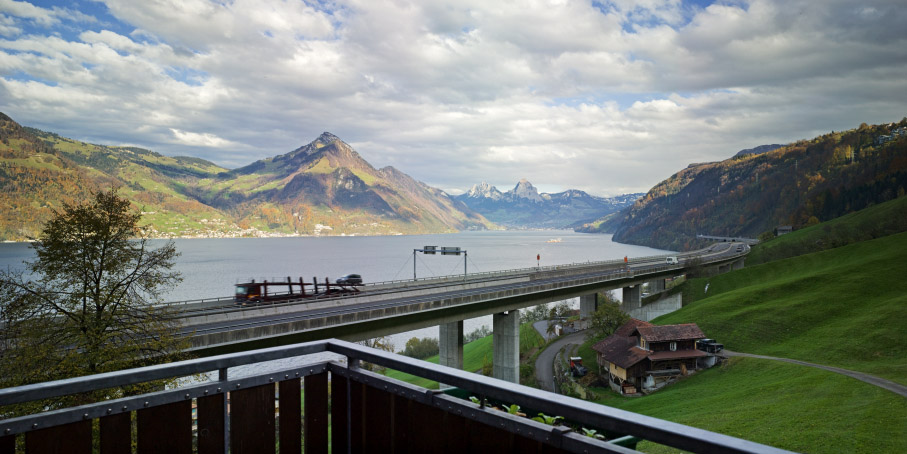Road accidents pursue downhill trend

Switzerland’s roads continue to become safer. For the first time since the 1950s the number of serious road accidents last year dipped below the 20,000 mark.
But despite the positive trend, experts say pressure should be maintained as bikers, cyclists and pedestrians are still at risk. The government’s new scheme for improving road safety, Via Sicura, is set to be discussed in parliament this autumn.
Figures released by the Federal Statistics Office on Tuesday showed that road accidents causing injury dropped by four per cent from 20,506 in 2009 to 19,609 in 2010. Fatal traffic accidents were also down by six per cent to 327 from 349.
Over recent decades while the number of motor vehicles has increased significantly, the statistics curve for road accidents has gone in the opposite direction. In 1971 some 30,000 serious accidents resulted in 1,773 fatalities, with half the number of vehicles on the roads as in 2011.
Road safety experts say the drop in injuries and deaths is largely down to advances in automotive technology, improved infrastructure and better policing.
“I think the main reasons behind the fall are technical ones,” Silvan Granig, spokesman for Road Cross, the Swiss foundation for victims of road accidents, told swissinfo.ch.
“Cars have got much safer over recent years with assisted-driving and warning systems that can tell you if you are on the wrong side of the road or beep when you are approaching something.”
New roads are wider and safety is now considered early on, he added.
But driver behaviour remains an issue. Momentary loss of concentration was responsible for 74 per cent of accidents causing injury in 2010, while lack of driving experience was cited in nine per cent of cases.
“The road accident statistics are better but you can also see that the way drivers behave hasn’t changed much and accidents resulting from the consumption of alcohol actually went up four per cent between 2009-2010 and more driving licences were taken away,” said Granig.
Pedestrians
And there is serious concern over the rise in fatal pedestrian accidents. The number of victims rose from 60 in 2009 to 76 in 2010.
Experts say this could come from a combination of factors: bad weather last year, a more mobile aging population and less consideration by both drivers and pedestrians.
“What we hear is that in Switzerland children are taught in the kindergarten to ‘wait, look, listen and then walk’ when crossing a road but our impression is that this is being forgotten in later life, especially with the use of things like mobile phones and iPods,” said Granig.
Daniel Menna, spokesman for the Swiss Council for Accident Prevention, said pedestrian crossing etiquette was problematic.
“In French-speaking regions car drivers don’t respect pedestrians’ right of way and in German-speaking regions pedestrians say they have the right to cross so think they can just jump out into the road without looking,” he told swissinfo.ch.
Another issue was modernising crossings, said Menna, with around 50 per cent not being safe enough.
Via Sicura
For the experts, despite the downwards trend in accidents, it is still crucial to fully implement the government’s proposed package of measures, Via Sicura, to make Swiss roads even safer.
The aim of the proposal, which was approved by the Senate in June and now moves to the House of Representatives, is to reduce the number of accidents by another 25 per cent.
“Every day one person dies and 12 people are seriously injured on the roads and many of these accidents don’t have to happen,” said Granig. “Road accident statistics have fallen in recent years but figures for bicycle, motorbike riders and pedestrians have stayed the same.”
The package includes measures such as not allowing children under seven to ride bikes on main roads and making driving licences valid for shorter periods. It also introduces tougher steps for reckless drivers and a ban on truck, bus and new drivers drinking and driving.
If all this is accepted, there could be 100 fewer deaths and 1,000 fewer severely injured people on the roads every year, said Menna.
But not everyone is happy with the new rules. “This continual fall over 15 years shows that measures taken are hitting their objectives and drivers are aware that they need to pay attention about the way they drive,” André Bugnon, a rightwing Swiss People’s Party parliamentarian, told Swiss public radio.
Via Sicura goes too far and is a constraint upon individual freedom, he said.
Official statistics revealed this year that 5.4 million motor vehicles were registered in Switzerland, up from just under 4 million in 1990.
Motorcycles have more than doubled in number from 299,264 vehicles in 1990 to 651,202 in 2010.
The number of diesel-fuelled vehicles on Swiss roads has risen 18% to 739,000, while some 17,100 hybrid vehicles are also in circulation.
Passenger cars using traditional petrol have been declining in popularity since 2003.
A 2008 survey by the gfs.bern research institute found that 80% of the Swiss population realised that cars had a negative impact on the environment – a 9% increase on a similar poll in 2005.
Two-thirds of those questioned said they could imagine buying a less-polluting car in future, and 88% favoured financial incentives to encourage purchases of green vehicles.
The poll found that every second person sat behind the wheel of his or her car at least once a day and 60% drive more than 100 kilometres a week. Both of these figures were down slightly compared with the 2005 survey.

In compliance with the JTI standards
More: SWI swissinfo.ch certified by the Journalism Trust Initiative















You can find an overview of ongoing debates with our journalists here . Please join us!
If you want to start a conversation about a topic raised in this article or want to report factual errors, email us at english@swissinfo.ch.